last modified: Friday, 18-Sep-2009 19:37:20 CEST
Document status: usable
The Ouachita Mountains (pronounced "wa-she-tah") that extend from Eastern Oklahoma to Central Arkansas are one of the most important sources of rock crystals. They have produced splendid crystals in large quantities for more than 150 years, rivaled only by Brazil and Madagascar.
Arkansas is the only place where large-scale mines are run for the sole purpose to extract rock crystals. Most of these quartz mines are registered in Mount Ida, Montgomery County, a few mines are located in neighboring Garland and Saline Counties. The Mount Ida Chamber of Commerce has put up the large sign at the highway to Mount Ida that you can see on the photo, an indication of the economic importance of quartz crystal mining in that area. It is estimated that in the high times of quartz crystal mining, the late 1980s and early 1990s, about 500 people were employed in the quartz crystal business (->Nichols 1999).
In April 2008 I spent a few days in the Ouachita Mountains to visit the mines and the rock shops associated with them.
Rock
crystals in the Ouachita Mountains are typically found in pockets inside quartz veins. These veins cut through various types of sedimentary rocks, usually sandstone, like in this specimen, which shows a small part of two adjacent veins. The sandstone is normally evenly stained brown by iron oxides, but here the sandstone has a patchy look because parts of the iron oxides got dissolved during the cleaning process. The lower vein is almost completely filled with white quartz, only a few small pockets bear small crystals. In the larger vein on top there was enough space left in a pocket for splendid rock crystals to grow. The Dauphiné habit of the rock crystals reveals the original orientation of the vein: the specimen would have to be turned first clockwise by about 90°, and then slightly tilted forward by about 30°. So the vein was cutting the rock vertically, which is typical for the Ouachita mountains.
This specimen is from the Collier Creek Mine, Mount Ida, Montgomery County.
Rock
crystals from Arkansas have a few typical but subtle properties that help to distinguish them from similar specimen from Brazil or Madagaskar.
the crystals are perfectly colorless if clear, unless they carry inclusions of colored minerals, most commonly limonite. Practically all smoky quartz crystals on the market, in particular those that are very dark, are artificially irradiated;
in particular in the Mount Ida area, the prism faces are shiny and generally show a fine and even striation, irregularities or discontinuities are uncommon. Quartz crystals found in the eastern part of the Ouachita Mountains are different in that respect and may be more difficult to distinguish from Brazilian specimen;
growth pits and etch structures on the prism faces, as they are commonly seen in Brazilian specimen, are mostly absent;
Dauphiné habit crystals are common in the Mount Ida area, less so in the eastern parts of the Mountains. Apart from that, normal habit crystals dominate, no Tessin or transitional habits have been reported;
s-faces are very common, other accessorial faces, including x-faces, are rare;
there is a relatively strong tendency to part parallel to the rhombohedral faces;
The crystal in the image is from the Clear Creek Mine, Mount Ida, Montgomery County. You can see another crystal's tip shining through the clear prism. The small blurred white reflections are caused by small quartz crystals that precipitated on the back side of the otherwise clear and shiny crystal, some of them peek around the edge of the prism on the right side.
The following growth forms, habits and twins can be found in the Ouachita Mountains:
Bent Quartz, indicating mechanical stress during growth
Faden Quartz, see below for their significance
Phantom Quartz
Dauphiné Habit
Japan Law Twins, together with Dauphiné habit crystals
"Jeffrey Quarry Solution Quartz", from North Little Rock, Pulaski County, a special growth form with haystack-like aggregates of crystals that have multiple small terminations instead of the usual single pyramid (some local collectors call similar specimen from Saline County "cactus quartz")
The image to the right shows rock crystals from Mount Ida with a very fine and even striation and a large rhomb-shaped s-face (the shiny face below the crystal's tip).
The specimen has another common feature, a milky extension of the left crystal at the base. Sometimes crystals with a relatively large "stem" are sold as "scepters", but technically this is not correct as i) the shape of the base is caused by growth inhibition and ii) the "head" is not an extension that is structurally different from the base or a second generation overgrowth[1].
Faden
quartz specimen are occasionally found in the Ouachitas. Some of them will be sold as "tabbies" (tabular crystals) if the faden is not clearly visible, but not all "tabbies" are faden quartz.
Faden quartz indicates that the cracks in the rock have opened steadily and slowly. The image shows a small part of a quartz vein in sandstone with a narrowing lower end. When the fissure opened, some of the quartz grains in the sandstone were split and rock crystals grew from their fresh fracture surface on both walls of the fissure. They developed into faden quartz crystals that were brigding the gap until the crystals' growth speed could not keep up with the widening of the fissure anymore (because either the fissure was widening faster or the growth speed was slowing down), so both ends of the crystals got separated and are now standing free on each side of the fissure. Because the walls were separating slower at the lower of the V-shaped fissure, one can still some faden quartz bridges there.
From the Clear Creek Mine, Mount Ida, Montgomery County.
This
specimen is less typical for Arkansas quartz. The crystals have partially turned white because of numerous cracks and healed fractures that were caused by mechanical stress during growth. The milky inclusions thus show a patchy distribution. Some of the smaller crystals that were well protected between the other crystals have remained almost free of cracks and look like typical rock crystals. The rough surface of most crystals and some regular patterns on the faces indicate growth inhibition by other minerals, possibly calcite or another carbonate mineral that got dissolved by acid during the regular cleaning process, as there are rhombohedral casts on the flip side of the specimen.
From the High Peak Mine, Mount Ida, Montgomery County.
This is a view of the Jim Coleman Mine in Garland County, a few kilometers north of Hot Springs Village. You can see two different rocks, a slightly silicified gray limestone, and a red sandstone stained by iron oxides. The rock crystals occur in more or less vertical quartz veins that run through both types of rocks. The larger crystals are found in the sandstone. It is very difficult to spot the veins in the sandstone because the veins are often stained by a reddish clay and covered by rubble from the walls.
Of course an open mine of this size cannot be operated with manual labor and hand tools. Above the center of the photo you can see an excavator charging a truck with rocks. The actual removal of crystals from the pockets is mostly hard manual labor, though, machines would damage the fragile content of the crystal pockets. To the right behind the trees there's a large pile that is open to collectors for a fee. Some mines even run small campgrounds for the rockhounds.
Outside the rock shop at the Jim Coleman mine cleaned quartz specimen are offered on large tables. Most mines run their shop at the streets, while the mines are a few miles away, well hidden in the forests (there's also a street shop of the Jim Coleman Mine).
Large matrix specimen, mostly from the Jim Coleman Mine, are spread on a plastic sheet to dry in the sun. These pieces are still to be cleaned from clay and brown iron oxides that cover the crystals, and dried mud and clay is easier to remove.
This is the largest quartz mine in operation, Ron Coleman's Mine, formerly known as Blocker Lead Mine, a few kilometers north of Hot Springs in Garland County. This mine has produced some of the largest rock crystal clusters in the world, some groups weighing more than 8 metric tons. You can see white quartz veins that run through sandstone walls.
Geology of the Quartz Deposits
Fig.2.1 shows a landscape in the Ouachita Mountains north of Mount Ida in April 2008. The Ouachita Mountains are a thinly populated low mountain range with altitudes of up to about 700m, covered with mixed and coniferous forests. The economy is mostly based on forestry, pastoral farming and tourism.
The Ouachita Mountains are mostly composed of sedimentary rocks of Ordovician age. The sediments have been deposited in a deep marine environment in the ocean south of the North American continental plate. During a collision with the South American plate in the late Carboniferous and early Permian age, the sedimentary rocks have been folded to form the Ouachita Mountain range. Because the mountains are very old, much of the rocks that built up the mountain range has been eroded away in time, and what now is at the surface was once buried under many kilometers of younger rocks.
During the collision of the continental plates, while the mountains were built up, the rocks got folded. Due to their physical properties and structure and depending on the temperatures, some rocks, like slates, shales and schists, can give in to some degree and will fold without cracking. Sandstone, however, is not as ductile as slate and will crack, with fissures running parallel to the folding. The Ouachita Mountains have been folded into mountain ranges with the ridges running roughly from East to West, and accordingly the fissures and quartz veins run along the mountains' crests in the same direction.
The fissures did not open up completely all of a sudden, at many places they opened gradually: this can be deduced from the fact that one can occasionally find faden quartz specimen in the pockets.
There's no unusual heat source at the base of the mountains, as the presence of hot wells in nearby Hot Springs National Park would suggest. This water has been heated because the arrangement of cracks in the rock layers allows for a circulation of waters through deep layers of rock. So the formation of the quartz crystals is not linked to a heat source like a magma chamber at shallow depths. In fact the quartz crystals are very old and probably formed during the Permian age, and their formation has nothing to do with the presence of the hot springs.
Numerous quartz crystals sit on top of a large boulder that lies at the entrance of the Jim Coleman mine. This is one wall of a thin quartz vein that once was running vertically through the sandstone. The quartz crystals are superficially stained orange, yellow and brown by limonite (hydrous iron oxides).
Digging for Crystals
If one walks through the forests of the Ouachita Mountains, one occasionally sees pieces of white quartz lying on the ground, like on the photo shot north of Lake Ouachita. Since the terrain is not very steep and the sticks and leaves on the forest floor keep the rocks from rolling over a long distance, the appendant quartz vein must be somewhere near, possibly immediately below the quartz pieces.
One would first check if the vein bears any crystals at all, and is not just made of massive milky quartz. The piece to the right, about 20cm long, carries numerous crystals, so the spot might be worth further investigation.
But while no one will object to picking up a crystal that lies on the surface on public land, you cannot just go and dig in the forest, of course. You need to apply for a mining permission.
I was very lucky to be invited by mine owner Stuart Schmitt to visit his Clear Creek Mine together with Ray and Larry and watch them work on the rock wall. The Clear Creek Mine is situated a few kilometers south of Mount Ida, like many of the mines in the Ouachita Mountains, on top of a long mountain ridge. It is a relatively small mine, but is quite productive.
Here you see Stu and Ray looking for signs of crystal pockets on the rock wall of the mine. On average, one can find a pocket every 2-3 meters along the wall. To the uninitiated the rock wall looks just like a wall of red-brown dirt and it is very hard to see any structure in it. In part this is so because top soil keeps trickling from the forest above the wall, in part it is because the sandstone is shattered by tectonic forces and reddish clay has filled all openings in it. The excavator that has cut through the wall has left white traces of crushed quartz on the wall, otherwise the quartz veins would be hardly visible.
After all agree on a good spot to dig, Ray starts the excavator and - very carefully - works on the wall to remove some rocks. Larry watches the process and takes care that the excavator does not cut through a pocket.
The crystals are usually removed from the wall by manual labor, using a large prybar as a lever. Close to the surface the sandstone rock is weathered and thus relatively soft, so it is not too difficult to work on.
A close-up of the wall, with the prybar used to loosen a slab of the wall. If you look at the high resolution version of this photo, you can see a few small crystal faces in the clay, mostly around and above the tip of the prybar: because the crystals are clear, the light gets "trapped" in them and they look dark. The pockets are not always intact and many have collapsed, so everything looks very messy. But as the pockets were filled with clay that embed and protect the crystals, most of them can be retrieved intact.
Stu is carefully removing a crystal-bearing piece from the wall, trying to not break the soft rock.
This is the piece shown in Fig.3.7. A few crystal tips are just barely visible in the mud, one can see some of their shiny triangular rhombohedral faces.
The crystal-bearing pieces are collected in buckets, the crystals still being protected by clay.
The devoted quartz collector, of course, would sit down and carefully check his finds and wrap them meticulously. But this is a commercial operation, and time is money, so it makes sense to risk breaking a crystal once in a while and speed up the whole process. The crystals are to be separated from the clay and their quality assessed later during the cleaning process.
Occasionally you can see well developed, shiny and clear crystals peeking out of the mud. Many of them are double-terminated crystals ("floaters"). Most of the times the crystals are covered with a tough iron oxide layer that makes it much more difficult to spot them. The Clear Creek Mine is an exception of that rule, here many crystals are shiny once the pocket clay is wiped off.
Of course, pieces that look promising (matrix specimen, larger crystals) will get wrapped in newspaper to protect them.
Fee Collecting Crystals
There are a number of fee collecting sites, but due to security regulations it is usually not possible to enter the mines to work on the walls yourself. Some of the small and medium-sized operations might let you in. Many of the mines allow fee collecting on dumps of material that has been piled up for collectors outside the mine. This is what is left over from opening the big pockets, but since the workers mostly concentrate on the larger pieces to sell in their shops, lots of specimen are overlooked that would make a collector happy. One hint for those who want to go there: don't expect the crystals to just lie around glistening in the sun, waiting for you to pick them up. Crystal pockets are mostly filled with red-brown clay and the crystals are often covered with a layer of yellow or orange limonite. So you have to work through the mud and dirt to find something.
Cleaning Crystals
The Clear Creek Mine is associated with the rockshop "Judy's Crystals 'N Things" east of Mount Ida (see Fig.4.1). Owner Judy kindly allowed me to take pictures of the process of cleaning the rock crystals from the Clear Creek and other mines.
The cleaning starts with sorting out larger crystals and matrix pieces from what has been brought in the buckets. The "rubble" gets spread on large tables made of wood and metal grid, where the smaller crystals are picked out. Maxine is wearing gloves for this work because the crystal points and chips are very sharp and the clay is a very tough stain.
The larger pieces are also placed on a wooden frame with a metal grid, and as a first step most of the reddish clay is hosed down with water. Then the crystals are left on the mesh to dry in the sun, so the clay that is still left on the crystals shrinks and cracks. When the crystals are washed again, this clay will come off more easily. If necessary, this process gets repeated until most of the clay is gone. You can also see that some of the crystals are yellow or orange by a tough layer of iron oxides that sit on the crystal faces and does not go away just by flushing the crystals with water.
This is what the crystals look like after the first cleaning steps. The crystals are put on a plastic platter to be placed in oxalic acid for a couple of days.
Oxalic acid removes iron oxides very effectively and is relatively easy to handle. Many collectors will clean their crystals in hydrochloric acid, but this is unsuitable for large scale operations because it gives off toxic fumes and large amounts are difficult to handle and store. Oxalic acid is highly toxic, too, if swallowed, and easily penetrates the skin, but overall its handling is much easier.
These are the platters and boxes with the crystals in the oxalic acid bath inside a large steel tub. If necessary, the oxalic acid bath can be warmed from below to speed up the dissolution of the iron compounds.
This is shop owner Judy flushing the crystals in a box that has just been taken out of the oxalic acid bath. If the crystals sit on a matrix or have a white base, it may be necessary to keep them in water or a diluted oxalic acid solution for a couple of days to let all the iron compounds diffuse out of the tiny cracks. If this is not done thoroughly, the matrix and the base of the crystals will turn yellow because the iron compounds accumulate at the surface when the iron-rich solution captured in tiny cracks slowly moves out and evaporates. Occasionally you can see such specimen with an unnaturally looking greenish-yellow matrix at a rock shop. Don't hesitate to buy them if you like them: You can place them in clean water for a couple of days and the yellow stain is gone.
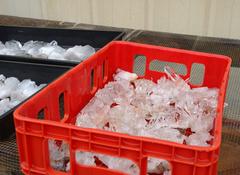
|
The flushed crystals in the box now look very shiny and almost perfectly clean. You can still see a few brown patches. Some of them cannot be removed, because these are iron compounds included in the crystals. Others are clay still left over in small crevices.
To remove the clay, individual crystals and specimens are cleaned with a high pressure water gun. As you can see, even the smaller crystals get a special treatment if necessary, so there's a lot of work to do until the crystals are ready to go to the shelves in the shops.
Ready to go, waiting for the customers. What you see on these tables is not necessarily from a single mine. As mentioned above, mine owners exchange pieces so they got a larger variety of crystals to offer at the shops. If you pick a crystal or crystal group, ask the dealer where it is from. In most cases the dealer will know because the crystals found at different mines differ in their look or in the type of matrix rock they sit on.
Further Information, Literature, Links
Arkansas Geological Survey
Arkansas Geologic Map - printable page-sized .pdf, at the Arkansas Geological Survey website
Quartz on the Ouachita National Forest by John C. Nichols, Forest Geologist, USDA Forest Service, 1999.
A good overview of the quartz mining history and mining operations in the Ouachita Mountains.
Rockhounding Arkansas, Quartz Crystals, Mike Howard's page on quartz, with an emphasis on Arkansas quartz specimen.
Footnotes
1
One would have a hard time finding a scepter on a Dauphiné habit quartz anyway.
 Printer Friendly Version
Printer Friendly Version
Copyright © 2005-2013, A.C. A k h a v a n
Impressum
- Source: http://www.quartzpage.de/ark.html
 1600x1600 645kb
1600x1600 645kb


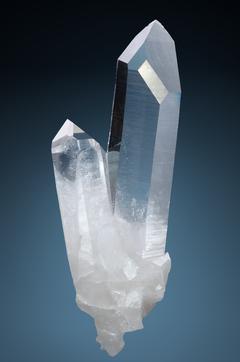
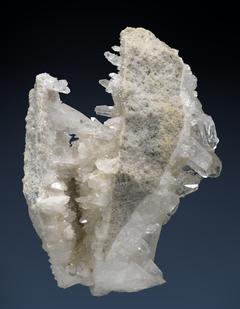




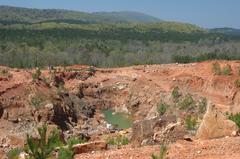
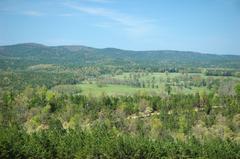

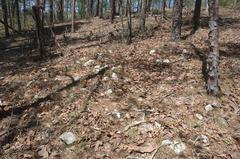



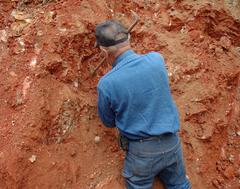

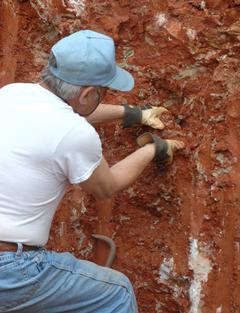
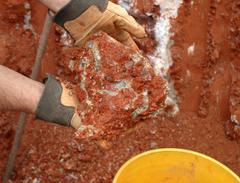
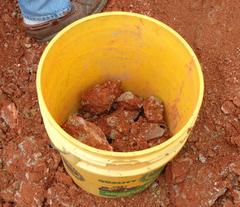


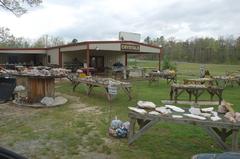


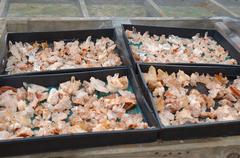
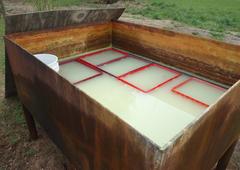



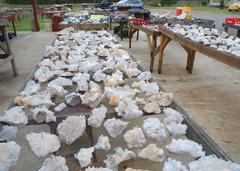
 Printer Friendly Version
Printer Friendly Version